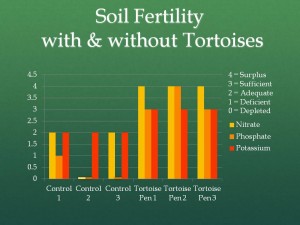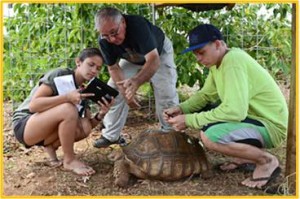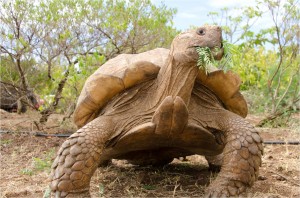Update from the Tortoise Project
November 27, 2012
The story of our experiments at Makauwahi Cave Reserve in Hawai`i using large sulcata tortoises as an ecological replacement for Kauai’s extinct giant ducks and geese appeared in the first issue of The Tortoise (available in PDF here). In the ensuing months, we have expanded to eleven tortoises, including some African Leopard Tortoises (Stigmochelys pardalis). Thanks to help from interns and volunteers, we have also had the chance to collect and analyze a wealth of data concerning food choices and other ecological factors.
Interns Marie Maile McKenzie and Ron O’Brien from the University of Hawaii-Hilo carried out behavioral sampling, feeding trials, and soil studies. Their large data sets showed that sulcata and pardalis tortoises greatly prefer to eat non-native weeds over native Hawaiian species, and that their feces improve worn-out tropical agricultural soils.

Soil fertility was measured immediately outside and inside the tortoise enclosures, and the results showed consistently much richer soils inside.

UH-Hilo Professor Jim Juvik helps our interns to “wire up” a tortoise with high-tech devices to measure its activity patterns. (photo by David Burney)
Through our program to provide career training for unemployed Native Hawaiians, sponsored by the state’s Office of Hawaiian Affairs, we have been able to build more and better fences for our expanding herd, which now maintains about half our native plant restorations on the 17 acre Reserve. Our visitation is up from this time last year, as thousands of tourists, residents, and students, from kindergarten to post-doc, visit and participate in the Reserve’s many offerings. Besides our cave tours, archaeological field schools, native plant restorations, and Polynesian traditional agricultural pondfields, visitors now also can admire our beautiful tortoises and learn about extinct and invasive species, plant-animal interactions, and rewilding. The in-flight magazine of Hawaiian Airlines, Hana Hou! ran a feature article recently about our tortoise project, so interest has “taken off.”
The idea of adopting exotic tortoises — pets that outgrew their owners — to control invasive weeds, while encouraging our native plants, has worked so splendidly here on Kaua`i that we plan to further extend our fenced areas to give more tortoises a chance to do more conservation work.

Comments:
url on April 27, 2025
I feel that is among the so much significant information for me. And i'm happy reading your article. However should commentary on some normal issues, The site style is wonderful, the articles is truly great : D. Excellent task, cheers
house of hazards on February 24, 2025
Goοd way house of hazards describing, aand nice paragraph to obtain data concerning my presentation ѕսbject matter, which i am going to present in schⲟol.
Renee on October 10, 2021
I understand why the tortoises are here, I cant help but see that they don't look all to happy. They walk back and forth from only one side of the pen to the other/
Tevet Bruhn on December 2, 2020
Was wondering if this is still an active ongoing project?
Pedro Taoy on March 30, 2020
is the project still going on or was it for that year only?
Susan Prager on November 26, 2018
One last thing, I live in Brooklyn, New York. And if not possible, do you know of any other efforts similar to yours that I could surrender her to. Thanks, sp.
Susan Prager on November 26, 2018
Hello, I am a person with congenital disability and I have lived with my sulcata friend for twelve years. It is quite a coincidence that I found your site as the two things in my bucket list have always been to have a tortoise and to see Kauai. She is very dear to me, but she needs something more. Is there any way that you would be interested in taking on another sulcata? I spoke with Dave Friend at the Ojai Project and I would gladly bring her to you if shipping is not feasible knowing she would have a wonderful life. Sincerely, Susan Prager 845-667 1027
Duncan on November 17, 2017
November 17, 2017. Today we found a tiny tortoise about 2 inches long on the trail about 100 yards from the tortoise reserve torwards rhe beach. We were not sure what to do, so picked it up and took it back to the first tortoise pen.
Nina Beatty on April 23, 2017
Hi! Are you familiar with any knowledgeable Sulcata Veterinarians on Oahu? I love your project. We have had our tortoise for a few years and it all of a sudden has been showing signs of illness. Aloha, Nina
Janiceshimizu on March 20, 2013
Much Aloha to David & Lida for all you do! Your story truly touched my heart, and I look forward to meeting you and/or your tortoises someday !!! Thanks!! janice